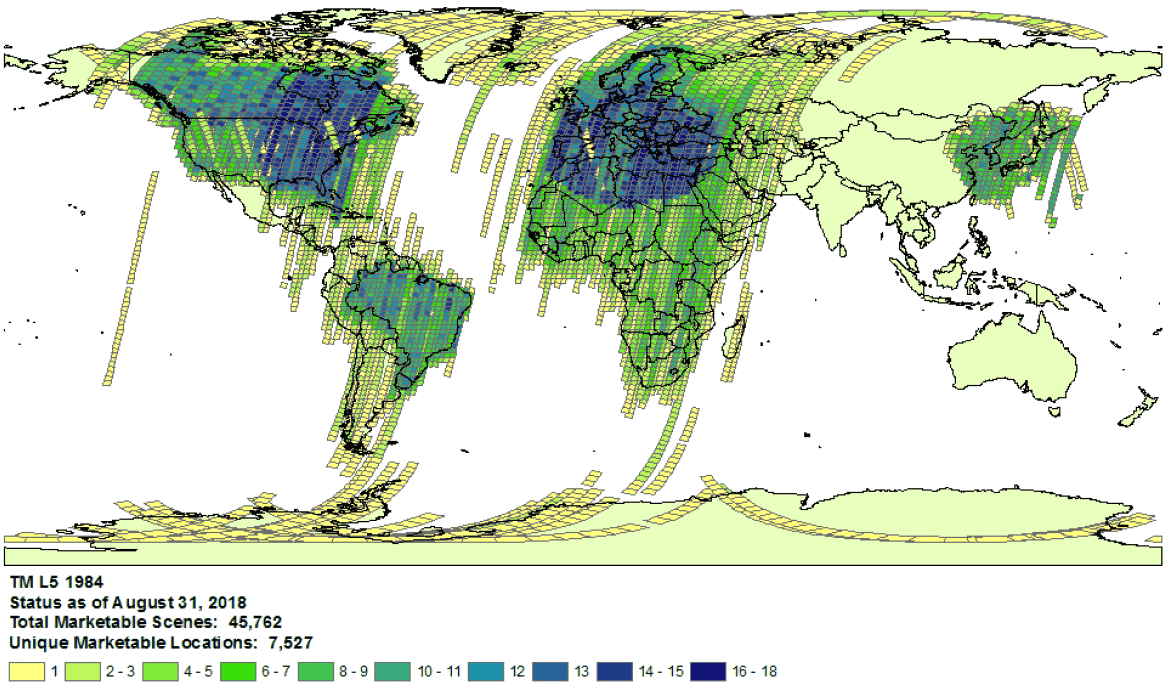이 문서의 목적은 Earth Engine 데이터 카탈로그 (현재 Landsat, Sentinel, MODIS)에 애셋이 누락되었는지 확인하는 것입니다.
다음 단계에서는 다음 작업을 수행하는 방법을 설명합니다.
Earth Engine 및 제공업체 카탈로그에서 사용 가능한 애셋을 확인합니다.
누락된 저작물 확인을 Earth Engine 데이터팀에 제출하는 데 필요한 정보를 수집합니다.
일반적인 고려사항
처리 수준: 특정 처리 수준 또는 제품에 따라 일부 이미지를 사용할 수 없을 수 있습니다. 예를 들어 품질이 낮은 이미지는 최고 수준으로 처리되지 않을 수 있습니다.
시공간적 노출 범위: 각 데이터 세트의 정기적 주기가 보장되지 않습니다. 센서 작업, 이미지 품질, 보관 파일 관리의 차이는 제공업체 데이터 가용성에 영향을 미칠 수 있습니다.
 1984년 Landsat 5 수집 범위의 예시입니다.
1984년 Landsat 5 수집 범위의 예시입니다.
- 제공업체 선택: 데이터 세트별로 선택된 제공업체의 데이터가 Earth Engine Data Catalog로 처리됩니다. 제공업체에서 전체 미션 보관 파일을 제공하지 않을 수 있습니다. 예를 들어 Landsat 데이터 세트는 특정 기간 동안 특정 수신소의 이미지가 누락된 것으로 알려진 USGS 보관 파일에서 처리됩니다 (자세한 내용은 LGAC 작업 참고).
Landsat
Landsat 데이터는 미국 지질조사국(USGS)에서 처리합니다.
관심 있는 시간과 지역의 Landsat 적용 범위 사용 가능 여부를 확인합니다.
Earth Engine에서 검색을 실행하여 관심 시간 및 관심 지역에 대한 모든 애셋 목록을 가져옵니다. 코드 내에서 실수로 확장 소재가 필터링되지 않았는지 확인합니다. 다음은 스크립트 예시입니다. 올바른 등급 및 처리 수준으로 컬렉션을 가져와야 합니다 (Landsat 컬렉션 구조에 대해 자세히 알아보기).
USGS Earth Explorer 카탈로그에서 누락된 애셋이 있는지 확인합니다 (검색 및 데이터 세트 선택에 관한 자세한 단계는 도움말 가이드를 참고하세요). 올바른 제품 및 처리 수준을 비교하고 있는지 확인합니다(Landsat 컬렉션 구조 참고). 표면 반사율 제품은 처리 수준이 L1TP인 Landsat 이미지에 대해서만 생성됩니다.
제공업체의 제품 ID와 애셋이 없음을 확인하는 Earth Engine Code Editor 스크립트의 링크가 포함된 티켓을 제출하여 누락된 애셋에 대한 자세한 증거를 공유합니다.
Sentinel
Sentinel 데이터는 Copernicus Dataspace 사이트에서 처리됩니다.
관심 있는 시간과 지역의 Sentinel 노출 범위 사용 가능 여부를 확인합니다 (임무 세부정보 참고).
참고: Sentinel-2 Level-2A 제품은 2018년 3월부터 유럽의 지상 세그먼트에서만 체계적으로 생성되었으며, 2018년 12월에 전 세계로 확대되었습니다 (자세한 내용은 ESA 사용자 가이드 참고). 이러한 페이지는 결국 컬렉션 1의 일부로 다시 생성됩니다.
Earth Engine에서 검색을 실행하여 관심 시간 및 관심 지역에 대한 모든 애셋 목록을 가져옵니다. 코드 내에서 실수로 확장 소재가 필터링되지 않았는지 확인합니다. 다음은 스크립트 예시입니다. 올바른 처리 수준으로 컬렉션을 가져와야 합니다.
Copernicus 카탈로그에서 누락되었을 수 있는 애셋을 찾습니다.
제공업체의 제품 ID와 애셋이 없음을 확인하는 Earth Engine Code Editor 스크립트의 링크가 포함된 티켓을 제출하여 누락된 애셋에 대한 자세한 증거를 공유합니다.
MODIS
MODIS 데이터는 Land Processes Distributed Active Archive Center(LP DAAC)에서 처리됩니다.
Earth Engine에서 검색을 실행하여 관심 시간 및 관심 지역에 대한 모든 애셋 목록을 가져옵니다. 코드 내에서 실수로 확장 소재가 필터링되지 않았는지 확인합니다. 다음은 스크립트 예시입니다. 원하는 제품을 가져오고 있는지 확인하세요.
USGS 데이터 풀에서 Earth Engine에 추가되지 않은 누락된 애셋이 있는지 확인합니다. 적절한 폴더로 이동하여 사용 가능한 최신 디렉터리를 확인합니다.
'MOD'로 시작하는 데이터 세트는 'Terra MODIS'에 있습니다.
'MYD'로 시작하는 데이터 세트는 'Aqua MODIS'에 있습니다.
'MCD'로 시작하는 데이터 세트는 '결합된 MODIS'에 있습니다.
'VNP'로 시작하는 데이터 세트는 'S-NPP VIIRS'에 있습니다.
제공업체의 제품 ID와 애셋이 없음을 확인하는 Earth Engine Code Editor 스크립트의 링크가 포함된 티켓을 제출하여 누락된 애셋에 대한 자세한 증거를 공유합니다.
